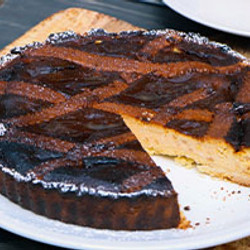Pastiera Napoletana has a dense filling and this is where you’ll start. First, add the grano cotto to a cooking pot (or use rice if you can’t find it in the store!). Then, add the milk.
Next, it’s time to add your butter into the pot along with 50g of sugar and the orange skin.
Mix this together using a wooden spoon and cook on medium-low heat until it is very sticky and the milk is absorbed—about 20 minutes.
While the filling is cooking, it's time to make the shortcrust pastry. Add the flour into the large stand mixer bowl along with room temperature butter, sugar, orange zest, and a pinch of salt.
Mix the dough until it is crumbly. This will take about 5 minutes.
Once the dough is ready, add in your eggs. Mix for another three minutes until the dough pulls away from the bowl.
Remove the dough from the bowl and knead it with your hands to give the dough shape.
Cut the dough into four equal pieces, then shape each piece into a flat round. This makes it easier to put it in the pie tray later.
You’ll want to make this dough ahead of time – it needs one hour to rest in the fridge and 1-2 hours outside of the fridge before baking. Wrap it in plastic wrap, so it doesn't dry out.
At this point, 20 minutes should have passed, and your cream is ready! It should be thick (like cooked oatmeal) at this point and bubbling slowly — now remove the orange skins with tongs.
Shift the cream into a large metal bowl to cool down, covering it with freezer paper, so it doesn't dry out. It's important to allow the cream to cool before adding in the ricotta.
Once the cream is cooled, combine the remaining sugar with the ricotta using another large mixing bowl.
Scrape the cooled wheat mixture into the ricotta and mix. Then, add in beaten eggs, cinnamon, and orange blossom water. Mix well before adding in orange peel – 200g (or as much/little as you like!).
Grab two sheets of baking paper and add your softened pastry dough round between them. Pound the dough down slightly, then begin rolling by pushing down in the middle then going forward and then down again in the middle and back. Your dough will be sticky, but you won't need to add extra flour because of the baking sheets.
Spray the tart pan with non-stick cooking spray and add in the rolled-out dough gently. To do this, first remove one layer of baking paper then lay the dough facing in on top of the pan and gently peel back the remaining sheet of baking paper letting the dough fall on top.
Help the pastry to sit inside the pan by pressing down with your fingers and then adjust if there are any cracks.
Cut any excess dough off if it is going over the edge.
If the pastry is uneven at the top or there are gaps, fill these in by adding extra dough to the edges and pressing down on them.
Roll out another round the same way you did to create the base. This will be used to create the strips to put on top of your pastiera. Slice using a pastry cutter – you’ll need seven strips for each pastiera.
Make sure you cover the strips using a sheet of baking paper while you’re pouring in the filling so they don’t dry out.
Using a ladle, add the filling into the crust, making sure to leave ½ centimeter at the top.
Place the strips on top of the pastiera making sure to have four pieces on the bottom and three crisscrossing pieces on top - this signifies the streets in the historical centre of Naples.
Time to put the pastiera into the oven at 175°C/347°F for 45 minutes. Then, drop the temperature to 150°C/302°F for the last 15 minutes.
Now, the most challenging part – letting the pastiera cool completely before taking it out of the baking pan! It will be easy to remove only once it’s fully cooled.
Leave the pastiera napoletana in the fridge to cool and remove it the next day.
Garnish with powdered sugar before serving.
E ora si mangia, Vincenzo’s Plate….Enjoy!
